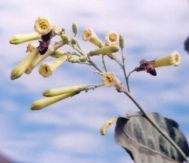Pollination ecology of the invasive tree tobacco Nicotiana glauca: comparisons across native and non-native ranges
DOI:
https://doi.org/10.26786/1920-7603(2012)12Abstract
Interactions with pollinators are thought to play a significant role in determining whether plant species become invasive, and ecologically generalised species are predicted to be more likely to invade than more specialised species. Using published and unpublished data we assessed the floral biology and pollination ecology of the South American native Nicotiana glauca (Solanaceae) which has become a significant invasive of semi-arid parts of the world. In regions where specialised bird pollinators are available, for example hummingbirds in California and sunbirds in South Africa and Israel, N. glauca interacts with these local pollinators and sets seed by both out-crossing and selfing. In areas where there are no such birds, such as the Canary Islands and Greece, abundant viable seed is set by selfing, facilitated by the shorter stigma-anther distance compared to plants in native populations. Surprisingly, in these areas without pollinating birds, the considerable nectar resources are only rarely exploited by other flower visitors such as bees or butterflies, either legitimately or by nectar robbing. We conclude that Nicotiana glauca is a successful invasive species outside of its native range, despite its functionally specialised hummingbird pollination system, because it has evolved to become more frequently self pollinating in areas where it is introduced. Its invasion success is not predictable from what is known of its interactions with pollinators in its home range.

Downloads
Published
How to Cite
Issue
Section
License
Copyright (c) 2012 Jeff Ollerton, Stella Watts, Shawn Connerty, Julia Lock, Leah Parker, Ian Wilson, Sheila Schueller, Julieta Nattero, Andrea A. Cocucci, Ido Izhaki, Sjirk Geerts, Anton Pauw, Jane C. Stout

This work is licensed under a Creative Commons Attribution 4.0 International License.











